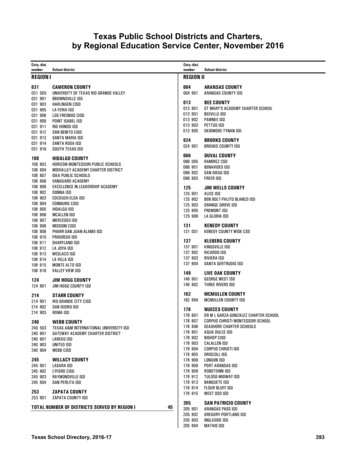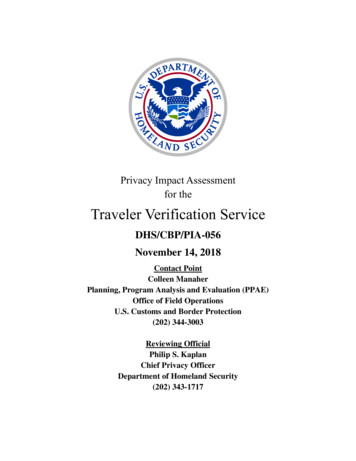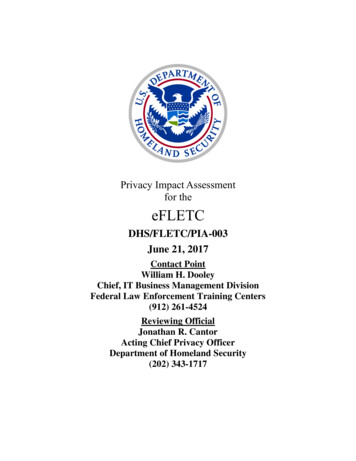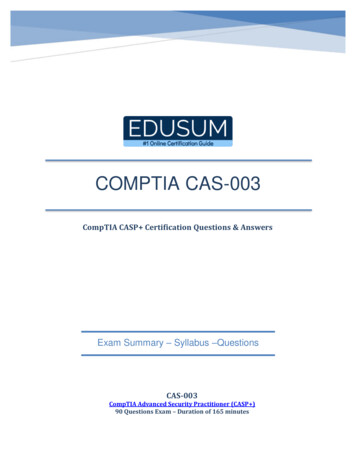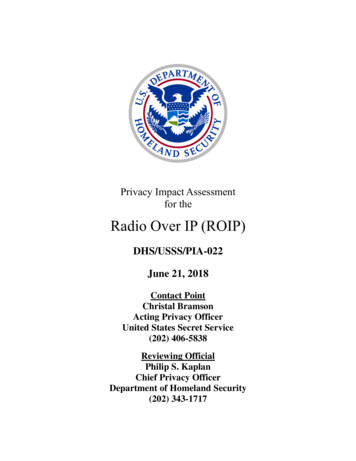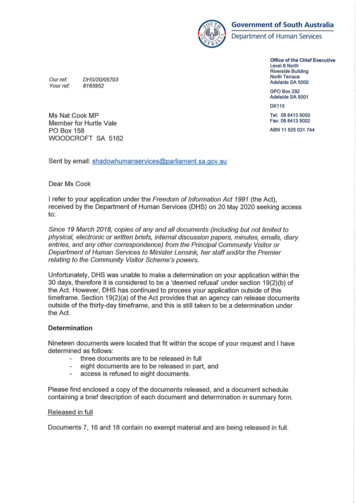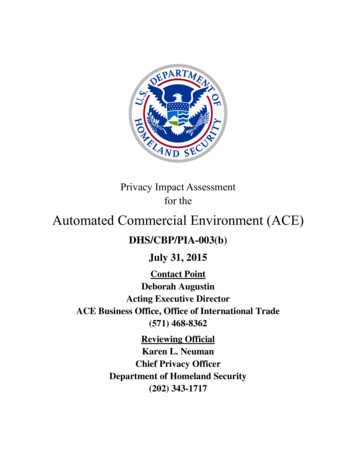
Transcription
Privacy Impact Assessmentfor theAutomated Commercial Environment (ACE)DHS/CBP/PIA-003(b)July 31, 2015Contact PointDeborah AugustinActing Executive DirectorACE Business Office, Office of International Trade(571) 468-8362Reviewing OfficialKaren L. NeumanChief Privacy OfficerDepartment of Homeland Security(202) 343-1717
Privacy Impact AssessmentDHS/CBP/PIA-003(b) Automated Commercial EnvironmentPage 1AbstractThe Automated Commercial Environment (ACE) is the backbone of the U.S. Customs andBorder Protection’s (CBP) trade information processing and risk management activities and is thekey to implementing many of the agency’s trade transformation initiatives. ACE allows efficientfacilitation of imports and exports and serves as the primary system used by U.S. Governmentagencies to process cargo. ACE will serve as the “Single Window” for trade facilitation asmandated by Executive Order 13659, Streamlining the Export/Import Process for America’sBusinesses. CBP published this Privacy Impact Assessment (PIA) for ACE because ACE collects,maintains, uses, and disseminates import and export information from the trade community thatcontains personally identifiable information (PII).OverviewBefore September 11, 2001, the major responsibility of the former U.S. Customs Service(“Customs”) was to administer the Tariff Act of 1930, as amended. When Customs subsequentlymerged with other border enforcement agencies to become U.S. Customs and Border Protection,CBP’s priority mission became homeland security: detecting, deterring, and preventing terroristsand their weapons from entering the United States. This mission fits ideally with CBP’s longestablished responsibilities for protecting and facilitating international trade. CBP retains itstraditional enterprise of protecting the nation’s revenue by assessing and collecting duties, taxes,and fees incident to international traffic and trade. Further, by providing procedural guidance tothe import community, CBP enhances and increases compliance with domestic and internationalcustoms laws and regulations. CBP thus helps importers ensure that their shipments are free fromterrorist or other malicious interference, tampering, or corruption of containers or commodities.CBP executes the responsibilities for which it has always been known: controlling,regulating, and facilitating the movement of carriers, people, and commodities between the UnitedStates and other nations; protecting the U.S. consumer and the environment against theintroduction of hazardous, toxic, or noxious products into the United States; protecting domesticindustry and labor against unfair foreign competition; and detecting, interdicting, and investigatingsmuggling and other illegal practices aimed at illegally entering narcotics, drugs, contraband, orother prohibited articles into the United States. CBP is also responsible for detecting, interdicting,and investigating fraudulent activities intended to avoid the payment of duties, taxes and fees, oractivities meant to evade the legal requirements of international traffic and trade; and for detecting,interdicting, and investigating illegal international trafficking in arms, munitions, currency, andacts of terrorism at U.S. ports of entry.
Privacy Impact AssessmentDHS/CBP/PIA-003(b) Automated Commercial EnvironmentPage 2CBP Entry ProcessWhen a shipment reaches the United States, the importer of record (i.e., the owner,purchaser, or licensed customs broker designated by the owner, purchaser, or consignee) will filethe necessary paper or electronic documents with CBP to facilitate the entry of the merchandise.1The importer of record files the entry with the CBP port director at the port where the merchandisearrived in the United States. The information filed as part of the entry must be sufficient to enableCBP to determine whether the imported merchandise may be released from CBP custody.Imported goods are not legally entered until after the shipment has arrived within the port of entry,delivery of the merchandise has been authorized by CBP, and estimated duties have been paid. Itis the importer of record’s responsibility to arrange for examination and release of the goods.Entry by ImporterMerchandise arriving in the United States by commercial carrier must be entered by theowner, purchaser, his or her authorized regular employee, or by the licensed customs brokerdesignated by the owner, purchaser, or consignee. Customs brokers are the only persons who areauthorized by the tariff laws of the United States to act as agents for importers in the transactionof their customs business.2Entries Made by OthersEntry of goods may be made by a nonresident individual or partnership, or by a foreigncorporation through a U.S. agent or representative of the foreign shipper, a member of thepartnership, or an officer of the corporation.3A licensed customs broker named in a CBP power of attorney4 may make entry on behalfof the foreign shipper or his representative. The owner’s declaration made by a nonresident“Entry” means that documentation required by 19 CFR § 142.3 to be filed with the appropriate CBP officer tosecure the release of imported merchandise from CBP custody, or the act of filing that documentation. “Entry” alsomeans that documentation required by 19 CFR §181.53 to be filed with CBP to withdraw merchandise from a dutydeferral program in the United States for exportation to Canada or Mexico or for entry into a duty-deferral programin Canada or Mexico (19 CFR § 141.0a(a)).2Customs brokers are private individuals or firms licensed by CBP to prepare and file the necessary customs entries,arrange for the payment of duties found due, take steps to effect the release of the goods in CBP custody, andotherwise represent their principals in customs matters.3The surety on any CBP bond required from a nonresident individual or organization must be incorporated in theUnited States. In addition, a foreign corporation in whose name merchandise is entered must have a resident agent inthe state where the port of entry is located who is authorized to accept service of process on the foreigncorporation’s behalf.4A nonresident individual, partnership, or foreign corporation may issue a power of attorney to a regular employee,customs broker, partner, or corporation officer to act in the United States for the nonresident employer. Any personnamed in a power of attorney must be a resident of the United States who has been authorized to accept service ofprocess on behalf of the person or organization issuing the power of attorney. The power of attorney to acceptservice of process becomes irrevocable with respect to customs transactions duly undertaken. Either the applicable1
Privacy Impact AssessmentDHS/CBP/PIA-003(b) Automated Commercial EnvironmentPage 3individual or organization, which the customs broker may request, must be supported by a suretybond providing for the payment of increased or additional duties found due.A nonresident, individual or partnership, or a foreign corporation may issue a power ofattorney to authorize the persons or firms named in the power of attorney to issue like powers ofattorney to other qualified residents of the United States and to empower the residents to whomsuch powers of attorney are issued to accept service of process on behalf of the nonresidentindividual or organizations.1. Entry of MerchandiseGoods may be entered for consumption,5 entered for warehouse at the port of arrival,6 orthey may be transported in-bond7 to another port of entry and entered there under the sameconditions as at the port of arrival. Arrangements for transporting the merchandise in-bond to aninland port may be made by the consignee, by a customs broker, or by any other person with aninterest in the goods for that purpose.“Entering” merchandise into the United States is a two-part process consisting of (1)admissibility and (2) characterization and value. For admissibility determinations, importers ofrecord must file the documents necessary to determine whether merchandise may be released fromCBP custody. For characterization and value determinations, importers of record must file thedocuments that contain information for duty assessment and statistical purposes. Both of theseprocesses can be accomplished electronically via the Automated Broker Interface (ABI) program.ABI is a voluntary program available to brokers, importers, carriers, port authorities, andindependent service centers. ABI allows brokers who have established accounts to electronicallyfile required import data with CBP.Entry documents may include but are not limited to: Application and Special Permit for Immediate Delivery (CBP Form 3461) or otherform of merchandise release required by the port director; Evidence of “right to make entry;”8CBP form (see Appendix) or a document using the same language as the form is acceptable. References to acts thatthe issuer has not authorized the agent to perform may be deleted from the form or omitted from the document.5“Entered for consumption” means that an entry summary for consumption has been filed with CBP in proper form,with estimated duties attached. “Entered for consumption” also means the necessary documentation has been filedwith CBP to withdraw merchandise from a duty-deferral program in the United States for exportation to Canada orMexico or for entry into a duty-deferral program in Canada or Mexico (19 CFR § 141.0a(f)).6“Entered for warehouse” means that an entry summary for warehouse has been filed with Customs in proper form(19 CFR § 141.0a(g)).7“Entered temporarily under bond” means that an entry summary supporting a temporary importation under bondhas been filed with Customs in proper form (19 CFR § 141.0a(h)).8All merchandise imported into the United States is required to be entered, unless specifically excepted (19 CFR §141.4).
Privacy Impact AssessmentDHS/CBP/PIA-003(b) Automated Commercial EnvironmentPage 4 Commercial invoice or a pro forma invoice when the commercial invoice cannot beproduced; Packing lists, if appropriate; and Other documents necessary to determine merchandise admissibility, includingdocuments required by other federal agencies.The entry must be accompanied by evidence that a bond has been posted with CBP to coverany potential duties, taxes, and charges that may accrue. Bonds may be secured through a residentU.S. surety company, and may be posted in the form of U.S. currency or certain U.S. Governmentobligations. In the event that a customs broker is employed for the purpose of making entry, thebroker may permit the use of his bond to provide the required coverage.2. Right to Make EntryGoods may only be entered into the United States by their owner, purchaser, or a licensedcustoms broker. A bill of lading,9 properly endorsed by the consignor, may serve as evidence ofthe right to make entry. An air waybill may be used for merchandise arriving by air. In mostinstances, entry is made by a person or firm certified by the carrier bringing the goods to the portof entry. This entity (i.e., the person or firm certified) is considered the “owner” of the goods forcustoms purposes. In certain circumstances, entry may be made by means of a duplicate bill oflading or a shipping receipt. When the goods are not imported by a common carrier, possession ofthe goods by the importer at the time of arrival shall be deemed sufficient evidence of the right tomake entry.Importer Security FilingOn January 26, 2009, a new rule titled Importer Security Filing and Additional CarrierRequirements (commonly known as “10 2” or ISF)10 went into effect. The ISF requires importersto submit 10 select data elements from the manifest and entry documents and two data elements(the “vessel stow plan” and the “container status message” from the shipper or carrier of themerchandise). The information submitted on the ISF improves CBP’s ability to identify high-riskshipments in order to prevent smuggling and ensure cargo safety and security.Importers submit ISF data to CBP via the Automated Commercial Environment (ACE)Secure Portal or the Electronic Data Interchange (EDI). However, ISF data is stored within CBP’s9A Bill of Lading is a commercially available document issued by a carrier to a shipper, signed by the captain,agent, or owner of a vessel, furnishing written evidence regarding receipt of the goods, the conditions on whichtransportation is made (contract of carriage), and the engagement to deliver goods at the prescribed port ofdestination to the lawful holder of the Bill of Lading. CBP regulates cargo declaration (CBP Form 1302) data inaccordance with the Customs Regulations at 19 CFR, Part 4.1073 FR 71730 (November 25, 2008).
Privacy Impact AssessmentDHS/CBP/PIA-003(b) Automated Commercial EnvironmentPage 5Automated Targeting System (ATS).11 For a full list of data elements required for the ISF, pleasesee Appendix B of the ATS PIA.123. Examination of Goods and Entry DocumentsFollowing presentation of the entry, the shipment may be examined or examination maybe waived. The shipment is then released if no legal or regulatory violations have occurred.Examination of goods and documents is necessary to determine, among other things: The value of the goods for customs purposes and their dutiable status; Whether the goods must be marked with their country of origin or require specialmarking or labeling. If so, whether they are marked in the manner required; Whether the shipment contains prohibited articles; Whether the goods are correctly invoiced; Whether the goods are in excess of the invoiced quantities or a shortage exists; and Whether the shipment contains illegal narcotics.Prior to the goods’ release, the port director will designate representative quantities forexamination by CBP under conditions that will safeguard the goods. Additionally, examinationsmay also be conducted by Partner Government Agencies (PGA) for merchandise that falls withinthose agencies area of responsibility, e.g., Food and Drug Administration (FDA). Some kinds ofgoods must be examined to determine whether they meet special requirements of the law. Forexample, food and beverages unfit for human consumption would not meet the requirements ofthe FDA.Importers of record, or their agents, must file entry summary documentation13 and depositany estimated duties within 10 working days of the entry of the merchandise at a designatedcustomhouse. Entry summary documentation consists of:11 Return of the entry package to the importer, broker, or his authorized agent after CBPpermits the release of the merchandise; Entry summary (CBP Form 7501); andDHS/CBP/PIA-006(b) Automated Targeting System (June 1, 2012), available ng-system-ats-update.12Id.13“Entry summary” means any other documentation necessary to enable Customs to assess duties, collect statisticson imported merchandise, and determine whether other requirements of law or regulation are met. (19 CFR §141.0a(b)).
Privacy Impact AssessmentDHS/CBP/PIA-003(b) Automated Commercial EnvironmentPage 6 Other invoices and documents necessary to assess duties, collect statistics, or determinethat all import requirements have been satisfied.ACE ModernizationAs a part of CBP’s mission to facilitate trade and enforce the nation’s import and exportlaws, CBP is engaged in an ongoing effort to modernize its business practices and informationtechnology (IT) assets. These IT assets are essential to securing U.S. borders, speeding the flow oflegitimate shipments, and targeting illicit goods that require scrutiny.15 The key IT component ofthese initiatives is ACE, an upgraded and modernized version of several legacy IT systems. ACEis the main IT component within the International Trade Data System (ITDS), an interagencyinitiative formalized under the Security and Accountability for Every Port Act of 2006 (the SAFEPort Act).1614On February 19, 2014, the President signed Executive Order (E.O.) 13659, Streamliningthe Export/Import Process for America’s Businesses, which establishes a deadline for completionof CBP’s modernization of ACE, requires PGAs to transition from paper-based forms to electronicdata collection, and calls for enhanced transparency requiring CBP to publicly post ACEmodernization implementation plans and schedules.17 To comply with E.O. 13659, CBP willcomplete the development of core trade processing capabilities in ACE and decommission legacysystem capabilities by December 31, 2016. At that time, ACE will become the “single window”18for trade processing and the primary system through which the international trade community willsubmit import and export data to various federal agencies. To meet this deadline, CBP willdecommission two major legacy IT systems: the Automated Manifest System (AMS) and theAutomated Commercial System (ACS). ABI (which was an integral part of legacy ACS) willremain the method by which electronic information is transmitted to ACE. ABI allows qualified14In 2014, CBP Officers processed more than 2.46 trillion in trade and nearly 25.6 million cargo containersthrough the nation’s Ports of Entry (POE).15On December 8, 1993, Title VI of the North American Free Trade Agreement Implementation Act (Pub. L. 103182, 197 Stat. 2057), also known as the Customs Modernization Act or “Mod” Act, became effective. Theseprovisions amended many section of the Tariff Act of 1930 and related laws. In support of the Mod Act, Customsbegan the ongoing process of modernizing its core trade processing functions and systems.16The ITDS, as described in section 405 of the Security and Accountability for Every Port Act of 2006 (the “SAFEPort Act”) (Public Law 109-347), is an electronic information exchange capability, or “single window,” throughwhich businesses will transmit data required by participating agencies for the importation or exportation of cargo.17Executive Order No. 13659, Streamlining the Export/Import Process for America’s Businesses (February 19,2014), available at ess-america-s-businesses.18Executive Order No. 13659, Streamlining the Export/Import Process for America’s Businesses (February 19,2014), available at ess-america-s-businesses.
Privacy Impact AssessmentDHS/CBP/PIA-003(b) Automated Commercial EnvironmentPage 7trade participants to electronically file required import data with CBP thus expediting the releaseof merchandise for the trade community.Since trade requirements will continue to evolve, CBP anticipates further development toensure trade automation capabilities in ACE. ACE will continue to adapt to meet changing needswith state-of-the-art automation that speeds legitimate trade and continually improves CBP’sability to assess risk and identify unsafe shipments. As CBP continues to develop capabilities tostreamline trade processes, this PIA will be updated.Single WindowE.O. 13659 mandates the implementation of a “single window” for trade.19 A singlewindow is an “electronic information exchange capability through which businesses will transmitdata required by participating agencies for the importation or exportation of cargo.”20 CBP isupgrading and modernizing ACE to serve as the U.S. Government single window by providing asingle, centralized access point to connect CBP, PGAs, and the trade community.21Forty-seven PGAs22 are involved in the trade process and among these PGAs nearly 200forms are required for importers and exporters to complete. The current processes are largelypaper-based and require importers and exporters to manually input information into multipleGovernment-owned electronic systems. As a result, importers and exporters are often required tosubmit the same data to multiple agencies at multiple times. The single window initiative is theeffort to create a single system to eliminate multiple paper processes and ensure importers andexporters only have to submit information once.Participating in ACEThere are two primary methods of interacting with ACE:1. Filing transactions via Electronic Data Interchange (EDI) Interface: With theexception of filing an electronic truck manifest and the ISF for low volume filers, EDIis the only mechanism through which transactions (entries, entry summaries, and oceanand rail manifests) can be filed in ACE.2. Filing transactions via the ACE Secure Data Portal: The ACE portal is an online toolthat allows users to file Importer Security Filing (ISF), electronic truck manifests, accessExecutive Order No. 13659, Streamlining the Export/Import Process for America’s Businesses (February 19,2014), available at ess-america-s-businesses.20Id.21See Appendix A for current list of PGAs with a signed Memorandum of Understanding with CBP.22From ensuring motor carrier safety to safeguarding against hoof and mouth disease, the 47 ITDS partnergovernment agencies currently slated for ACE integration are as diverse as international trade is complex. The PGAsrepresent ten cabinet level and four independent departments/agencies. For additional information about PGAs,please visit gas/.19
Privacy Impact AssessmentDHS/CBP/PIA-003(b) Automated Commercial EnvironmentPage 8financial data, and run reports. ACE reports can be used to monitor compliance and dailyoperations.Electronic Data Interchange (EDI)EDI is an electronic communication framework that provides standards for exchangingdata via any available electronic means. Trade filers are able to electronically transmit import andexport data to CBP through EDI. Filings transmitted through EDI link to all CBP systems,including ACE. Electronic communication through EDI allows trade filers to receive fasterdecision responses for the movement of cargo. Business entities that wish to communicate via EDIto CBP may use a certified software provider, become a self-filer, or contract a service center.EDI allows the trade community to file: Importer Security Filing Data;
Privacy Impact AssessmentDHS/CBP/PIA-003(b) Automated Commercial EnvironmentPage 9 Import Ocean, Rail, or Truck Manifests; Entries; Entry Summaries; Export commodity data; and Supporting documentation.Members of the trade community may opt-in to receive automated status notices from EDI.ACE Secure Data PortalThe ACE Secure Data Portal is a web-based interface for ACE available atwww.cbp.gov/trade/automated that provides a centralized online access point to connect CBP,trade representatives, and PGAs involved in importing goods into the United States. The portalprovides account holders the ability to identify and evaluate compliance issues, monitor dailyoperations, set up payment options, review filings, access a reports tool, compile data, and performnational trend analysis.ACE Secure Data Portal allows the trade community to: File Importer Security Filing Data; File Import Truck Manifests; File Responses to CBP Forms 28, 29, and 4647; Run reports; Manage account and Periodic Monthly Statement Information; Create blanket declarations; and File Import or Export Bonds.With respect to accounts, the portal provides access to transaction and financial data andpermits users to download large quantities of account data and transfer that data to their ownreporting system. The portal enables users to enroll in Periodic Monthly Statement and customizepayment schedules. Within the portal, the portal updates Account Revenue data hourly; MultiModal Manifest data every two hours; and compliance data monthly. All other reporting data isupdated nightly.The ACE Secure Data Portal helps improve compliance with trade laws by allowing usersto run targeted reports to conduct in-house audits, identify systemic errors, and be provided withinsight into entries under review by CBP. The portal also facilitates identification of unauthorizedfilers and allows the monitoring of cargo carrier activity by driver, conveyance, or equipment.
Privacy Impact AssessmentDHS/CBP/PIA-003(b) Automated Commercial EnvironmentPage 10Users may also monitor rail and sea in-bond movements, bills of lading manifest, and equipmentdata.ACE Account AccessIn order to participate in ACE, requesting participants must submit a letter of intent (LOI)requesting access to a specific system and an Interconnection Security Agreement (ISA)23 toconnect to a CBP IT system. The LOI should be submitted to letterofintent@cbp.dhs.gov oncompany letterhead.Account types within ACE can be categorized into three broad groups. The access groupscurrently available within ACE include: Filers – Broker, Filer, and Surety; Service Providers – Software Vendor; Service Bureau; Port Authority; Preparer; andSurety Agent; and Operators – Facility Operator (Warehouse, Container Freight Station, ContainerExamination Station), Foreign Trade Zone Operator, Cartman/Lighterman,24 AirCarrier, Rail Carrier, Sea Carrier, Truck Carrier, and Driver/Crew.Data elements required by CBP for ACE account access vary for each of these groups, andeach data element is discussed in turn in Section 2.1.ACE Modules and FunctionalityOnce participants have filed an LOI or ISA as required, and completed the user accountregistration process, ACE users can access several modules within ACE to conduct their tradebusiness:1. ManifestACE e-ManifestACE currently supports the processing of rail, sea, and truck electronic manifests.Electronic manifests allow the Government to more quickly determine if incoming cargo poses aCBP Information Systems Security Policy requires all participants that transmit electronic data directly to CBP’sautomated systems to file a signed Interconnection Security Agreement (ISA). If an entity is using a connectionalready established through a Service Center or VPN, an ISA may not be required. For additional information andrequired forms see edi.24A “cartman” is one who undertakes to transport goods or merchandise within the limits of the port (19 CFR §112.1). A “lighterman” is one who transports goods or merchandise on a barge, scow, or other small vessel to orfrom a vessel within the port, or from place to place within a port (19 CFR § 112.1).23
Privacy Impact AssessmentDHS/CBP/PIA-003(b) Automated Commercial EnvironmentPage 11risk or can proceed into the country. CBP will expand ACE to include air electronic manifests in2015.ACE e-Manifest accepts manifest data electronically submitted by importers, carriers, andbrokers. Truck carriers are able to file manifests via EDI or the ACE Secure Data Portal; however,ocean, rail, and air carriers25 transmit their manifest data solely by EDI. ACE manifestfunctionality also allows for enhanced capabilities such as managing the financial details relatedto importation of merchandise for authorized users. CBP sends status messages and replies viaEDI.2. Cargo ReleaseCargo ReleaseThe first requirement to enter merchandise into the United States is a successful finding ofadmissibility by CBP. For admissibility determinations, importers of record must file thedocuments necessary to determine whether merchandise may be released from CBP custody. Thisis known as “cargo release.”After importers of record file manifest and informal entry information26 via EDI or theACE Secure Portal, cargo can be released from the port and the importer has up to 10 days to fileentry summary information (including any duty payments). ACE Cargo Release module allowsimporters to file the entry information electronically. This data fulfills merchandise entryrequirements and allows CBP to make earlier cargo release decisions. This, in turn, provides morecertainty for the importer in determining how long the cargo will take to be released from CBPcustody. Cargo may be released in-bond pending the completed entry summary.3. Post ReleaseACE participants can file entry summaries in ACE for Antidumping/Countervailing Duty(AD/CVD), Consumption, Formal, and Informal entry types (Types 01, 03, 11). ACE PeriodicMonthly Statements also allow participants to pay duties and fees on a monthly basis rather thantransaction by transaction.Entry SummaryACE participants may submit their entry summary (the formal, legal submission of animported commodity’s description, quantity, value, country of origin, customs duty obligation,and the commodity’s satisfaction of any other PGA requirements that affect admission into U.S.25CBP provided a free method of submitting data, given the very large number of North American truck carriers. Atlast tally, there were 400,000 registered, many of which are typically small business owners. While not all areinternational crossers, the cost associated with buying a software solution to communicate with ACE would not havebeen practical for many of the carriers.26Importers that wish to file informal entry in advance of the formal entry summary (CBP Form 7501) may file aCBP Form 3461.
Privacy Impact AssessmentDHS/CBP/PIA-003(b) Automated Commercial EnvironmentPage 12commerce) for their imported commodity. ACE fully replaces the former paper processes, whichhelps to decrease courier and administrative costs for the importing community.ACE provides the functionality to process “edits” or checks, which validate the accuracyof the data on the entry summary. ACE provides automated validation calculations for such itemsas the harbor maintenance fee, commodity classification, simple and complex duty calculations,the merchandise processing fee, entry restrictions, taxes, and other associated fees.Electronic Bond Filing (eBond)In January 2015, CBP launched capabilities in ACE that enable electronic bond filing(eBond). eBond allows the importer to iden
A licensed customs broker named in a CBP power of attorney4 may make entry on behalf of the foreign shipper or his representative. The owner's declaration made by a nonresident 1 "Entry" means that documentation required by 19 CFR § 142.3 to be filed with the appropriate CBP officer to

